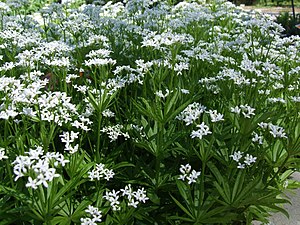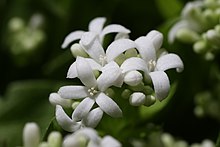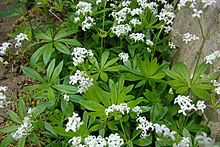Woodruff
| Woodruff | ||||||||||||
|---|---|---|---|---|---|---|---|---|---|---|---|---|

Woodruff ( Galium odoratum ) |
||||||||||||
| Systematics | ||||||||||||
|
||||||||||||
| Scientific name | ||||||||||||
| Galium odoratum | ||||||||||||
| ( L. ) Scop. |
The Woodruff ( Galium odoratum ), also Fragrant bedstraw or Woodruff called, is a plant from the genus of Galium ( Galium ). It mostly thrives in deciduous forests in the temperate latitudes of Eurasia . The best-known ingredient of the woodruff is the coumarin . Woodruff is used as a medicinal and aromatic plant, for example for the woodruff punch.
description
Vegetative characteristics

Woodruff grows as a wintering green, perennial herbaceous plant and reaches stature heights of 5 to 50 cm. This hemicryptophyte forms subterranean, thin, more or less long rhizomes as persistence organs with which the woodruff can also reproduce vegetatively . Your upright, straight, four-sided stems are smooth and bare, except at the nodes ( Nodien ), which are short haired stiff.
The six to eight leaves standing in whorls on the stem are stalked up to a millimeter long when seated. The simple, single-veined leaf blade is elongated-lanceolate or narrow-elliptical with a length of usually 15 to 50 (6 to 65) mm, a width of usually 4.5 to 15 (3 to 17) mm and a length / width ratio of about 4: 1. The blade narrows at the base from a pointy to a wedge shape, the tip is pointed or blunt with an abrupt spike tip. The flat leaf margin is rough. The leaf surfaces are largely bare; there may be forward microhairs on the top and midrib on the bottom. The leaves become papery as they dry.
Generative characteristics
The flowering period extends from April to May or June, depending on the location. A few to many flowers are grouped together in a terminal, zymous inflorescence . There may be bracts similar to foliage . The flower stalks have a length of 1 to 4 millimeters.
The small, hermaphrodite flowers are radially symmetrical and four-fold. The chalice is only rudimentary . The four white or bluish-white, glabrous, 4.5 to 6.5 mm long and 3 to 7 mm wide petals are fused more or less broadly funnel-shaped over about half of their length. The corolla lobes are triangular-spatulate with a pointed upper end. There is only a circle of mostly four fertile stamens which are inserted in the corolla tube. Two carpels are long mm to an under constant, about 0.8, ellipsoidal to inverted-egg shaped, rigid short hairy ovary fused, a seed plant containing per ovary chamber. The two styles are free up to the top, each with a cephalic scar. There is a discus .
The dry split fruit breaks down into two solitary partial fruits. The 2 to 3 mm long, egg-shaped to almost spherical partial fruits are covered with 1 to 1.2 mm long, hooked bristles. With the bristles, the partial fruits cling to fur, plumage or clothing as Velcro fruits and can thus be spread out widely. The fruits ripen between June and September.
Chromosome number
The chromosome number of the species is 2n = 44.
ingredients
When withered and dry, the plants release coumarin , which causes the characteristic woodruff odor. In order to imitate the characteristic woodruff taste, the food industry uses the chemically only slightly modified 6-methylcoumarin . The coumarin content is around 1% of the dry matter on average. Other ingredients are iridoid glycosides , asperuloside and monotropein .
ecology
The woodruff is an evergreen geophyte and chamaephyte with rhizomes.
Woodruff is one of those plant species that develop their male stamens earlier than the female reproductive organs, a strategy that promotes cross- pollination . The flowers are white, "small funnel-shaped flowers". Mostly pollination takes place by flies ; self-pollination is also possible.
The fruits are bristly hairy cleft fruits that support the Velcro spread. The seeds are frost germs .
The vegetative reproduction takes place very abundantly through runners .
Several tensioner species specialize oligophagous on Galium as the Woodruff as caterpillar food plant, the Rotbinden-blade tensioner (or dark red mountain forest-blade tensioner) ( Catarhoe rubidata ), the Olive mountain forest-blade tensioner ( Colostygia olivata ), the smoke brown cleaver blade tensioner ( Lampropteryx suffumata ) of Ravine bedstraw ( Nebula tophaceata ) and polyphagous the yellowish-white small wrench (or bedstraw small wrench ) ( Scopula floslactata ).
The woodruff is attacked by the rust fungi Puccinia asperulae-odoratae with aecidia , uredia and telia or by Thekopsora guttata with uredia and telia.
Occurrence

The woodruff comes from northern , central and eastern Europe to the Asian part of Turkey , the Caucasus and Kazakhstan, as well as western Siberia , Altai , Algeria, China, Japan and Korea. The plant is a neophyte in North America . It usually thrives at altitudes of up to 1400 meters in temperate and cool zones. In the Allgäu Alps , it rises in the Tyrolean part of the Schartschrofen up to 1580 m above sea level.
In Central Europe , the woodruff grows most frequently in shady red beech forests (the species is named for the woodruff beech forest ), but also occurs in oak-hornbeam forests . Woodruff prefers fresh, loose, nutrient- and base-rich soils and indicates clay soils. The woodruff is according to Oberdorfer Kennart of the association Asperulo odorati-Fagetum sylvaticae (Galio odorati-Fagetum) H. May. 1964 em. Oberd. 1983 (including Melico-Fagetum Lohm. In Seibert 1954) and Kennart of the association Fagion sylvaticae Pawl. 1928, its main deposit is in the Carpinion Issl association. 1931 em. Oberd. 1953.
Systematics
This species was in 1753 under the name Asperula odorata by Linnaeus in Species Plantarum first published . It was placed under the now accepted name Galium odoratum by Giovanni Antonio Scopoli in the genus Galium in 1771 .
use
Woodruff is used as a spice plant, for example in the production of woodruff punch , ice cream or syrup. It is used as a moth control , folk medicinal plant and in homeopathy . Woodruff has a vasodilator, anti-inflammatory and antispasmodic effect. The drug , the herb collected and dried before flowering, is called herba Asperulae odoratae or Galii odoratae herba . The woodruff owes its typical aroma to the coumarin . The artificial taste of woodruff, which is added to many foods, is produced by 6-methylcoumarin .
According to Madaus, only medieval sources mention the herb as strengthening the heart and making it sweaty, against liver problems and jaundice . Lonicerus ' Kreuterbuch (1564) praised the fact that it cools the inflamed liver, opens the blocked liver, and acts as a plaster for suppuration and hot ulcers. From Haller's Medicin. Lexicon (1755) knows it as liver and wound herb, Osiander's folk remedy (1829) as a cough suppressant, Aschenbrenner's The Newer Drugs (1851) as a diuretic , for ascites , Schulz's effect and use of German medicinal plants as tea for hydrops and lithiasis . According to Leclerc , it paralyzes the brain, so according to Madaus it helps with spasms , facilitates sleep and digestion, “especially when this is accompanied by dizziness and fear”, increases urine and makes it clearer. Folk medicine and Kneipp used the herb for abdominal pain, chest pain and headache, for calming, for coughing, wounds and toothache. It is mostly used in the tea mix. A very small dose of fresh plants has a refreshing effect.
mythology
Woodruff is said to have been used as a remedy against demonic forces. In Poznan , cows that refused to eat were given woodruff with a little salt. Witches were allegedly driven away by a mixture of woodruff, St. John's wort and Härtz bilge ( Mentha pulegium ).
toxicology
Woodruff is classified as slightly to hardly poisonous. The main active ingredients of the woodruff are the 0.28% coumarin glycosides contained in the fresh herb . When it wilts, it releases coumarin , which can cause drowsiness and headaches as well as liver damage when consumed frequently.
Assuming that fresh woodruff releases an average of 1.06% coumarin in the dry matter and that it has an average dry matter of 14.5%, no more than about 3 g of fresh herb should therefore be used to make 1 liter of punch .
Since 1974, the until then widespread use of woodruff flavoring for lemonades and sweets, which were mainly consumed by children, has been banned in Germany; the addition of coumarin in flavorings to foods is limited to two milligrams per kilogram. The coumarin content of commercially produced May punch and other alcoholic beverages must not exceed five milligrams per liter in Germany. The Tobacco Ordinance in Germany prohibits the use of woodruff in tobacco products.
etymology
The woodruff appears in older botanical writings as lat. Matrisylva , stellaria , hepatica , alyssum; Conrad Gessner has it under the names rubia silvatica aspera and muschetum minus , Tabernaemontanus as herbam cordialem .
Other German trivial names included Waldmeier , Mösch , Mäserich , Mai (en) kraut , Zehrkraut and Herz (ens) freu (n) d . In the German-speaking area, the following other trivial names are or were used for this plant species, sometimes only regionally: Gliedegenge ( Silesia ), Gliedekraut (Silesia), Gliederzunge, Gliedzwenge, Halskräutlein ( Alsace ), Herfreudeli ( Bern , Freiburg), Herzfreud, Liverwort, Mäsch ( Mecklenburg ), Mariengras, Massle, Meesske ( East Prussia ), Fragrant Megerkraut, Meiserich, Meister ( Westphalia ), Mentzel, Meserich (Silesia), Meusch (Mecklenburg), Möschen ( Holstein , East Prussia), Möseke (Mark near Rheinsberg ), Schumarkel, Sternleberkraut ( Switzerland ), Theekraut (Switzerland), User leiven Fraun Bedstoa ( Göttingen ), Waldmännlein and Wooldmester ( Bremen , Unterweser ).
There are various possible explanations for the German trivial name Waldmeister , which is most widespread today : It is interpreted as 'master of the forest', i.e. the first and most important plant in the forest, or in the sense of a "plant growing in the forest with masterful healing power". In terms of content, the trivial names are similar in Serbian , where the woodruff is called prvenac ('firstling', 'leader'), in French , where he is called pure des bois ('queen of the woods'), and in the Latin name matrisylva (' Forest Mother '). Another assumption is that woodruff is distorted from the designation Wald-Mösch (en) or -Meiserich , which either refers to a Low German derivation of mos ('moss') or like the French (petit) muguet in late Latin muscus ('musk') ) is traced back, or from the name Waldmeier; Meier is the German-language name for the genus Asperula , to which the woodruff was previously assigned as Asperula odorata . The term Meier is in turn understood as a variant of the plant name Miere , which has been known as myer since the 15th century . In addition, the name is also associated with a hypothetical Middle Latin form herba Walteri Magistri , which is said to have been translated into German as Waltermeister , with the names Middle English herbe wauter and Middle Latin herba Walteri , which were documented in the 13th century .
See also
literature
- Tao Chen, Friedrich Ehrendorfer: Galium . In: Wu Zheng-yi, Peter H. Raven, Deyuan Hong (Eds.): Flora of China . Volume 23: Acoraceae through Cyperaceae . Science Press / Missouri Botanical Garden Press, Beijing / St. Louis 2010, ISBN 978-1-930723-99-3 , Galium odoratum , p. 131 (English, online ). (Sections Description, Systematics and Distribution)
- Woodruff. In: FloraWeb.de. (Sections description, plant sociology and caterpillar forage plant)
- Siegmund Seybold (Ed.): Schmeil-Fitschen interactive . CD-ROM, version 1.1. Quelle & Meyer, Wiebelsheim 2002, ISBN 3-494-01327-6 .
- Karl Hiller, Matthias F. Melzig: Lexicon of medicinal plants and drugs. 2nd Edition. Spectrum, Heidelberg 2010, ISBN 978-3-8274-2053-4 .
- A. Kerner : The flower of the May drink . In: The Gazebo . Issue 16, 1867, pp. 245–247 ( full text [ Wikisource ]).
- Distribution in the northern hemisphere from: Eric Hultén, Magnus Fries: Atlas of North European vascular plants . 1986, ISBN 3-87429-263-0 ; The virtuella floran. (Swedish)
Web links
- Galium odoratum (L.) Scop., Woodruff. In: FloraWeb.de.
- Woodruff . In: BiolFlor, the database of biological-ecological characteristics of the flora of Germany.
- Galium odoratum (L.) Scop. In: Info Flora , the national data and information center for Swiss flora .
- Thomas Meyer: Data sheet with identification key and photos at Flora-de: Flora von Deutschland (old name of the website: Flowers in Swabia )
Individual evidence
- ↑ a b c Woodruff. In: FloraWeb.de.
- ^ Erich Oberdorfer : Plant-sociological excursion flora for Germany and neighboring areas . 8th edition. Verlag Eugen Ulmer, Stuttgart 2001, ISBN 3-8001-3131-5 , page 765.
- ↑ a b c Lutz Roth , Max Daunderer , Kurt Kormann : Toxic Plants - Plant Poisons. Poisonous plants from AZ. Emergency assistance. Occurrence. Effect. Therapy. Allergic and phototoxic reactions . 4th edition. Nikol, Hamburg 2000, ISBN 3-933203-31-7 , pp. 364 (reprinted 1994).
- ↑ a b c d Ruprecht Düll , Herfried Kutzelnigg : Pocket dictionary of plants in Germany and neighboring countries. The most common Central European species in portrait . 7th, corrected and enlarged edition. Quelle & Meyer, Wiebelsheim 2011, ISBN 978-3-494-01424-1 , p. 349-350 .
- ↑ Peter Zwetko: The rust mushrooms Austria . (PDF; 1.8 MB) Supplement and host-parasite directory for the 2nd edition of the Catalogus Florae Austriae , III. Part, Book 1, Uredinales .
- ^ Galium odoratum in the Germplasm Resources Information Network (GRIN), USDA , ARS , National Genetic Resources Program. National Germplasm Resources Laboratory, Beltsville, Maryland.
- ↑ Rafaël Govaerts (ed.): Galium odoratum. In: World Checklist of Selected Plant Families (WCSP) - The Board of Trustees of the Royal Botanic Gardens, Kew . Retrieved June 4, 2020.
- ↑ Erhard Dörr, Wolfgang Lippert : Flora of the Allgäu and its surroundings. Volume 2, IHW, Eching 2004, ISBN 3-930167-61-1 , p. 505.
- ↑ Carl von Linné: Species Plantarum. Volume 1, Lars Salvius, Stockholm 1753, p. 102 ( digitized version ).
- ^ Giovanni Antonio Scopoli: Flora carniolica exhibens plantas Carnioliae indigenas et distributas in classes, genera, species, varietates, ordine linnaeano. Editio secunda aucta et reformata. Volume 1, Ioannis Paulus Krauss, Vienna, p. 105; bibdigital.rjb.csic.es (PDF).
- ↑ Galium odoratum at Tropicos.org. Missouri Botanical Garden, St. Louis
- ↑ S. Schönfeldt: The great Ravensburger book of festivals and customs: Through the year and the curriculum vitae. Otto Maier, Ravensburg 1987, ISBN 3-473-42349-1 .
- ^ W. Fürst, K. Schuler: Hospitality trades: basic and specialist level. 3. Edition. Bildungsverlag EINS, Troisdorf 2002, ISBN 3-441-92650-1 .
- ^ P. Hahn: Lexicon of food law. Behr, Hamburg 1998, ISBN 3-86022-334-8 .
- ^ Manfred A. Fischer, Karl Oswald, Wolfgang Adler: Excursion flora for Austria, Liechtenstein and South Tyrol . 3rd, improved edition. State of Upper Austria, Biology Center of the Upper Austrian State Museums, Linz 2008, ISBN 978-3-85474-187-9 .
- ^ Siegmund Seybold (Ed.): Schmeil-Fitschen interactive . CD-ROM, version 1.1. Quelle & Meyer, Wiebelsheim 2002, ISBN 3-494-01327-6 .
- ^ Gerhard Madaus: Textbook of biological remedies. Volume I. Olms, Hildesheim / New York 1976, ISBN 3-487-05890-1 , pp. 637-641 (reprint of the Leipzig 1938 edition) (online) .
- ^ Eduard Hoffmann-Krayer, Hanns Bächtold-Stäubli: Concise dictionary of German superstition . Volume 9. De Gruyter, Berlin 1987, ISBN 3-11-016860-X , p. 62.
- ↑ a b Lutz Roth, Max Daunderer, Kurt Kormann: Toxic Plants - Plant Poisons. Occurrence, effect, therapy, allergic and phototoxic reactions. With a special section about poisonous animals. 6th, revised edition, special edition. Nikol, Hamburg 2012, ISBN 978-3-86820-009-6 , p. 364.
- ↑ Eberhard Teuscher: Spice Drugs. A guide to spices, aromatic herbs, spice blends and their essential oils. Wissenschaftliche Verlagsgesellschaft, Stuttgart 2003, ISBN 3-8047-1867-1 .
- ↑ a b Real Woodruff ( Memento from March 2, 2013 in the Internet Archive ) DGEinfo 05/2008 - Consulting practice, from June 2, 2008.
- ↑ Consumers who consume a lot of cinnamon are currently exposed to too much coumarin . Health assessment of the BfR No. 043/2006 of the Federal Institute for Risk Assessment , p. 1, June 16, 2006 bfr.bund.de (PDF).
- ↑ a b Heinrich Marzell , Heinz Paul: Dictionary of German Plant Names I. Leipzig 1943. (Reprint: Cologne 2000, ISBN 3-88059-982-3 , p. 469 ff.)
- ^ Georg August Pritzel , Carl Jessen : The German folk names of plants. New contribution to the German linguistic treasure. Philipp Cohen, Hannover 1882, p. 47, ( Textarchiv - Internet Archive ).
- ^ Günther Drosdowski, Annette Klosa (Red.): Duden - dictionary of origin. Etymology of the German language (= Der Duden. Volume 7). Reprint of the 2nd edition revised according to the rules of the new German spelling. Dudenverlag, Mannheim 1997, ISBN 3-411-20907-0 , p. 799. (entry forest )
- ^ Gerhard Madaus : Textbook of biological remedies. Olms Verlag, Hildesheim 1999, ISBN 3-487-05889-8 . (Reprint of the Leipzig 1938 edition).
- ↑ Woodruff . In: Jacob Grimm , Wilhelm Grimm (Hrsg.): German dictionary . tape 27 : W – way [twittering] -zwiesel - (XIII). S. Hirzel, Leipzig 1922, Sp. 1169–1171 ( woerterbuchnetz.de ).
- ↑ Friedhelm Sauerhoff: Plant names in comparison. Franz Steiner, Stuttgart 2001, ISBN 3-515-07857-6 , p. 171, limited preview in the Google book search.







